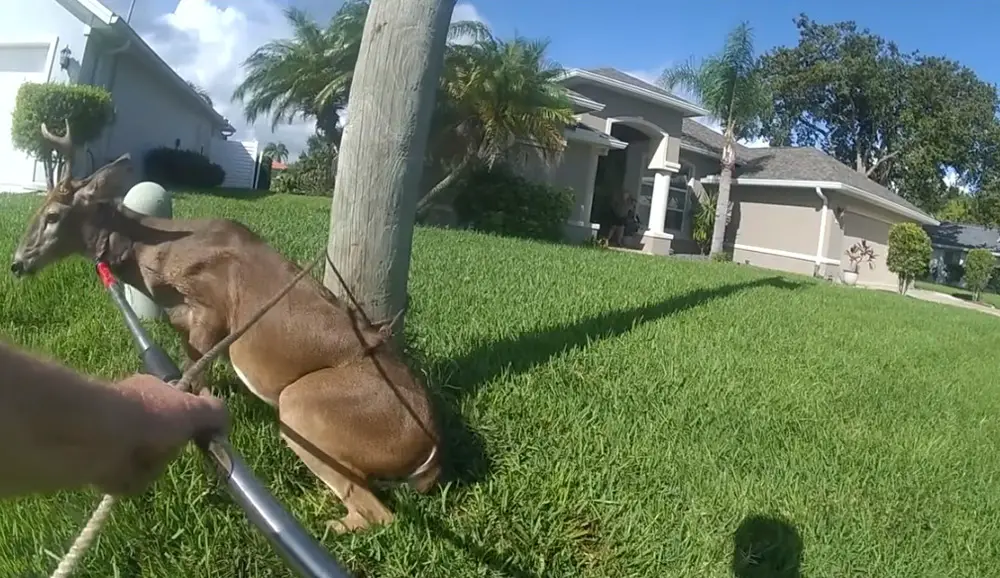
A trio of Palm Coast residents indignant at the euthanizing of a domesticated deer by throat-slitting in early October addressed the Dec. 5 meeting of the Florida Fish and Wildlife Conservation Commission and got what appeared to be an immediate response: FWC, one of whose officers was responsible for killing the animal, has changed its euthanizing policy to prevent similar outcomes in future.
“We just this morning finalized that official policy to ensure that situations like this won’t happen like that again,” FWC Executive Director Roger Young said. “We understand that there were some mistakes made and that we need to get better in that practice. And we finalized that policy this morning. So that’ll be made available.” He added: “Just want to make sure we’re clear and we hear you and we’re learning and we’re doing what we can to make it better.” A request to FWC for the new policy was not fulfilled before this article initially published.)
Mike Hansen had just finished giving the commission a brief biography of the relatively short life of the deer he’d rescued and adopted after finding him orphaned at the side of a road after his mother had been killed by a car. The deer, he said, “identified as a dog.” He acknowledged that it was a bit crazy for him to take in the deer, but the deer took to the domestication, responding th commands, acting like a family pet, walking in and out of the back door at will, enough to cause Hansen’s electric bills to shoot up to $500 a month. “It even started laughing like humans when I had friends around,” he said.
He named the deer Baboo.
The morning of Oct. 5, the Flagler County Sheriff’s Office responded to a complaint of a man being attacked by Baboo as the man was in his garden, who had allegedly “tried to gore” the 911 caller as well, according to 911 notes. The wife of the man took him to a clinic to get checked out. The extent of the man’s injuries are unclear (Hansen described the injuries as a “scratch,” and that the man hadn’t appreciated the deer eating his shrubs, but the deer had a broken antler, which could have caused a serious injury). Sheriff’s Agriculture/Ranch deputy Steve Williams responded, and called in an FWC officer.
“FWC told me to put it down if I get on scene first but not to shoot it in the head as it will need to be tested,” Williams reported in his notes. While not routine, it is not uncommon for deputies and other law enforcement officers to use their service weapons to kill deer in certain circumstances. But the approach may be different in an urban setting. “The deer could not be safely put down due to its location among the houses,” Williams reported. “Officer Harris from FWC arrived on scene and he agreed it was not safe to use a firearm to put the deer down.” It is not clear why killing the deer was the only option.
Williams was not the primary responder in that case: the FWC officer would be, and FWC policy would apply. In a long and disturbing sequence captured on his body cam and uploaded to the Palm Coast Observer’s YouTube channel–the Observer first reported the story in October–Williams, either just before the FWC’s officer’s arrival or with the officer standing by, is seen attempting to get control of the deer with a noose.
Read Related Also: Detroit Man Formally Charge with Murder, Following Death of Synagogue Leader Samantha Woll
The deer was seemingly compliant, unafraid of being near Williams. “He’s not afraid of us at all,” Williams says. But as soon as the noose is around the deer’s neck, the deer begins to buck and fight, and Williams says the deer is attempting to go after him. The deer is eventually under control, and the FWC officer proceeds to cut him. But it’s not a quick end. (“This is what happens when people feed deer around here,” Williams says to an onlooking neighbor. “Now we got to put a deer down because somebody wants to feed ’em.”)
The deer fights, bleeds out over minute after painful minute as the video continues, life draining out of him and staining the grass red in front of 10 Cool Water Court. Another FWC officer wonders out loud why not put a bullet in the deer’s head, or behind his neck if his head had to be examined. The deer’s head could not be compromised so it could be examined in a necropsy in Gainesville.
“There is no playbook that says you slit an animal’s throat and wash it suffer for 15 to 20 minutes. There just is not one in any realm of any reality of law enforcement,” Hansen told the Commission in Orlando. He’d wished the deer had been at least allowed to go back into the woods. “Some training needs to get done. And that’s all I’m requesting for you all to do,” Hansen told the commission.
A Palm Coast couple had also addressed the commission, describing how “Baboo was nursed into self-sufficiency,” and was free to roam in and out of the house and into the nearby preserve. The resident the commission chair referred to as Joanne said “Baboo made a mistake on October 5 by coming into contact with a man who was in his yard pulling weeds.” She then described the deer’s last 15 minutes at the hands of the FWC officers and the deputy. Since they knew the animal was domesticated, they should have asked themselves, ” What do we do with a friendly domesticated neighborhood pet.” The FWC officers, she noted, did not have a tranquilizer kit.
Her husband, Jeff, pointed out inconsistencies between the way FWC narrated its incident report and what was evident in the video: the incident report implicitly skips over the 15 minutes of pain the deer endured. It was “at best misleading and at worst, a lie,” Jeff told the commission. “This gap would also not be discoverable by anyone investigating incidents of inhumane animal treatment.”
![]()







